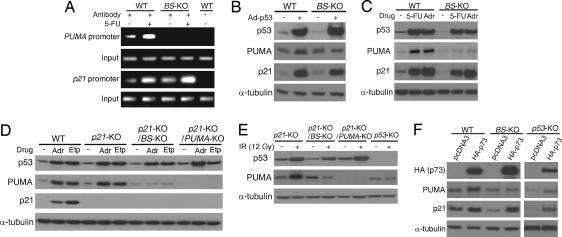Fig. 2.
Induction of PUMA by DNA-damaging agents requires direct binding of p53 to the PUMA promoter. (A) The binding of p53 to the PUMA promoter. WT and BS-KO HCT116 cells were treated with 5-FU for 12 h. The bindings of p53 to the PUMA and p21 promoters were analyzed by ChIP, followed by PCR. Amplified region in the PUMA promoter is 5′ to the deleted region in the BS-KO cells. Amplified region in the p21 promoter is across the p53-binding sites. (B–F) Isogenic HCT116 cells with different p21, PUMA, BS, and p53 genotypes were subjected to the indicated treatments. Expression of p53, PUMA, and p21 was analyzed by Western blotting. α-Tubulin was used as the loading control. (B) Cells were infected with an adenovirus expressing p53 (Ad-p53) for 24 h. (C) Cells were treated with 5-FU (50 μg/ml) or adriamycin (Adr; 0.4 μg/ml) for 24 h. (D) Cells were treated with adriamycin (Adr; 0.4 μg/ml) or etoposide (Etp; 40 μM) for 24 h. (E) Cells were exposed to γ-irradiation (IR; 12 Gy), and cell lysates were prepared 24 h after the exposure. (F) Cells were transfected with HA-tagged p73 (HA-p73) or the control empty pCDNA3 vector. Cell lysates were prepared 24 h after transfection.

